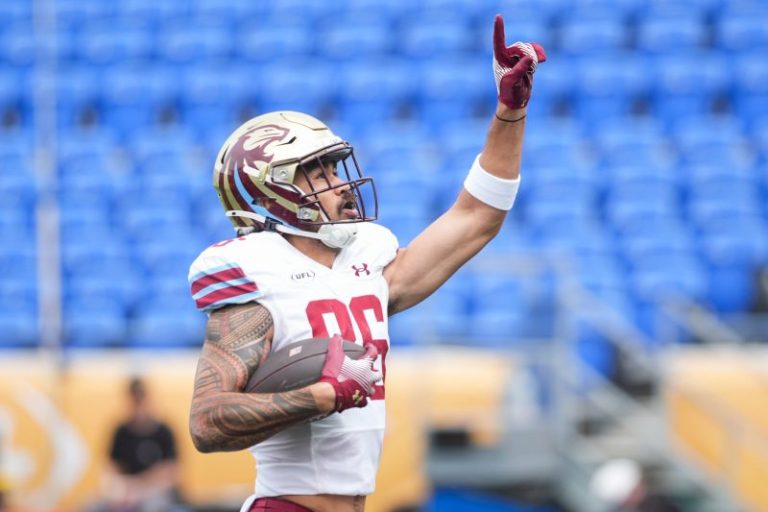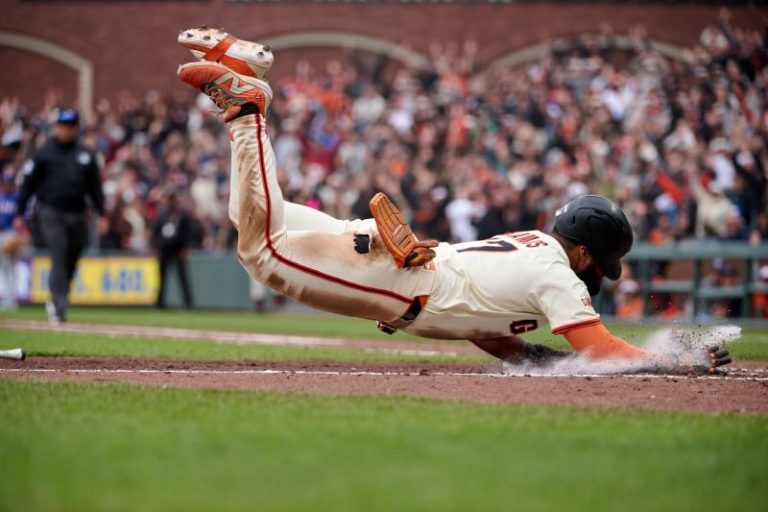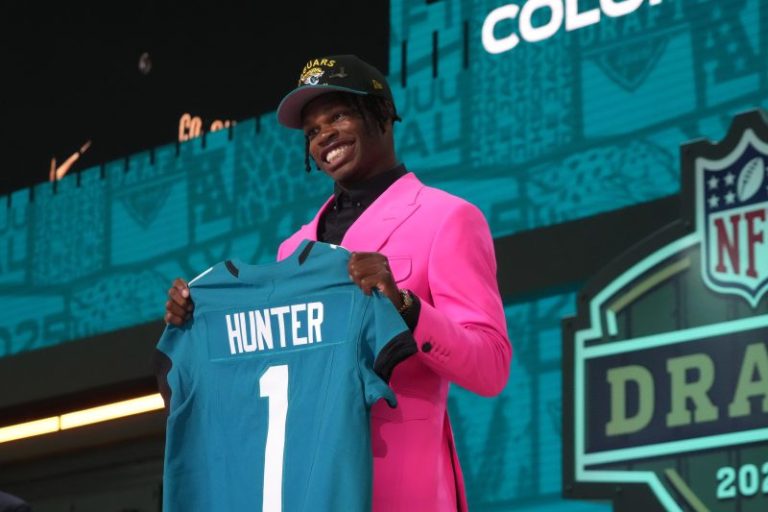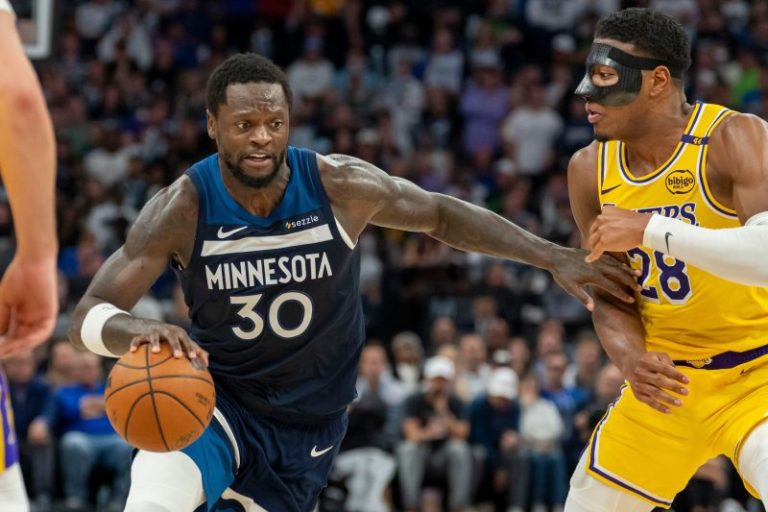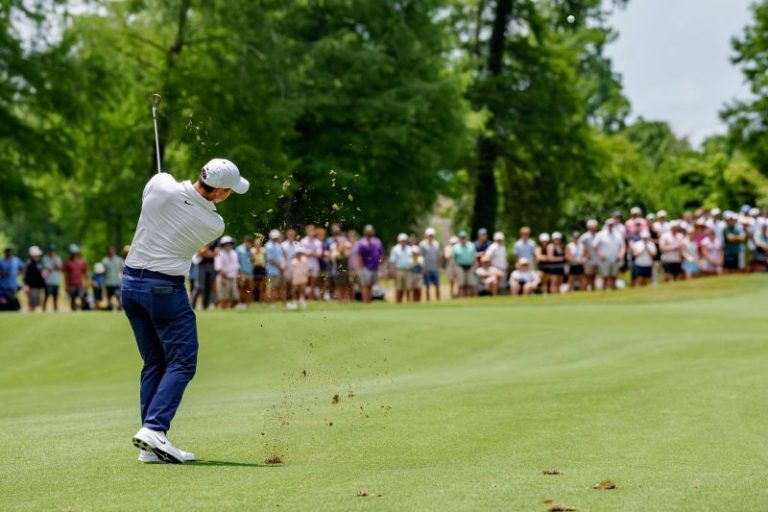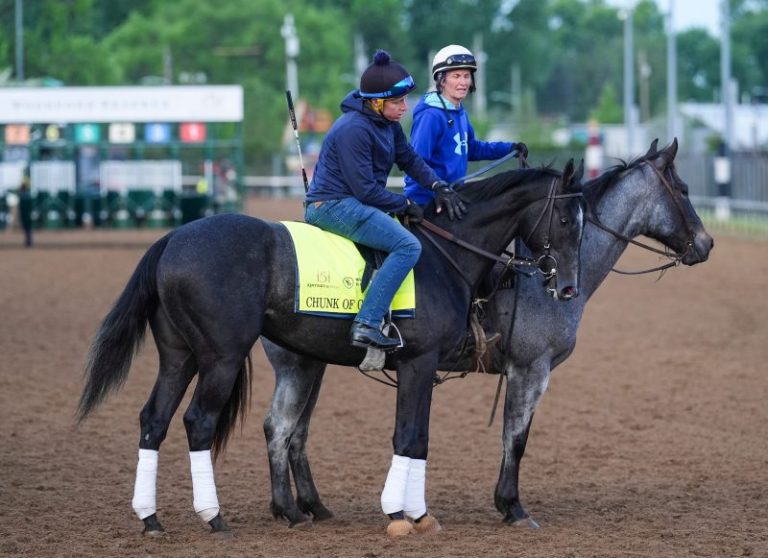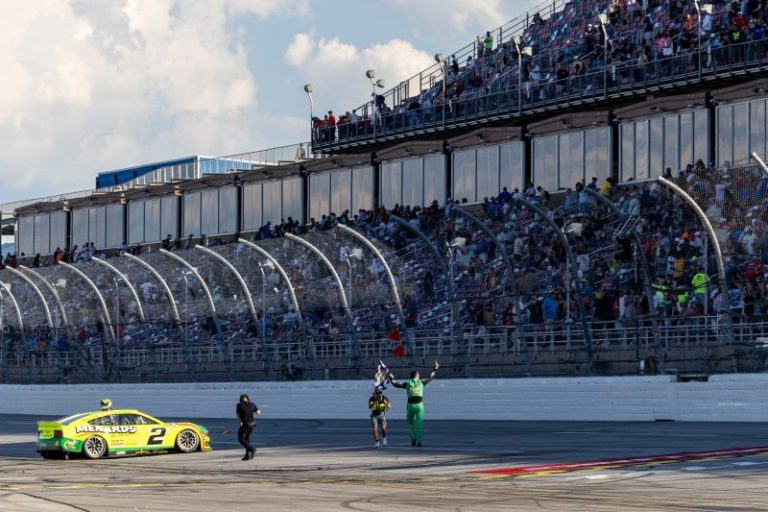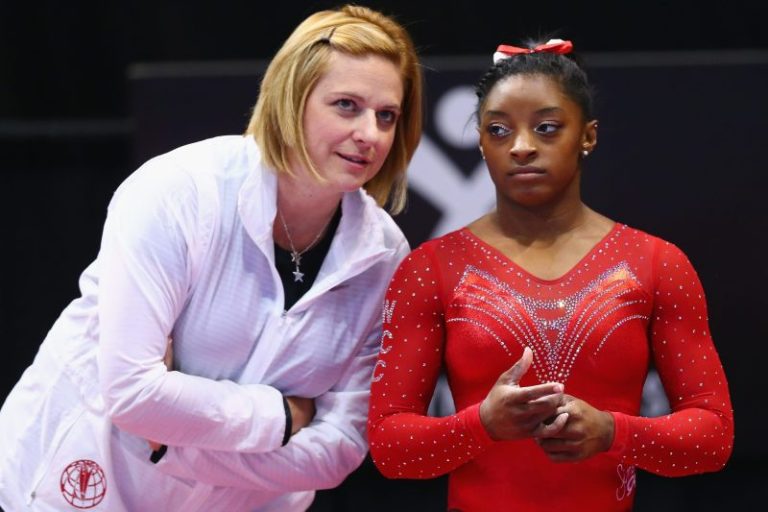‘Simone never would have made it in my gym.’
Aimee Boorman has heard that line, over and over, from other coaches when they talk about the gymnast she helped lift to heights never seen within their sport.
‘They say it with a sense of pride,’ Boorman tells USA TODAY Sports, ‘and it’s like, ‘So you realize how many potential Simones you have pushed out of your gym?’ ‘
Biles was the kid who always loved the gymnastics part, but not the work that went into making her the best. Some days she just wanted to go home.
Those characteristics didn’t necessarily change as she grew into the decorated champion America knew. Boorman, though, was willing to manage them in a way others wouldn’t.
Biles’ coach from age 7 through her four-gold-medal performance at the 2016 Rio Olympics remembers her as one of her more challenging pupils.
‘If everybody is just strict and obedient, you grow stale as a coach,’ Boorman says. ‘So when you have somebody who’s throwing something new at you all the time, on an emotional level, on a personality level, you gotta grow. And I think some of those other coaches weren’t willing to grow.
‘When people say, ‘Well, there’s only going to be one Simone,’ I’m like, ‘That’s not true.’ You have to know how to manage that athlete to get them to the point they could be a Simone.’
Boorman’s approach – nurturing, forgiving, even relenting – was novel to coaching within a sport of forced discipline and regulation. She lays out her methodology, ingrained in her by a tumultuous childhood experience, in ‘The Balance: My Years Coaching Simone Biles.’
The book, which was released last week, reveals a back story of how athletes develop and mature but also how they can have giggles on their face before and after their most triumphant Olympic moments.
Boorman and co-author Steve Cooper spoke with us about facing unique challenges while coaching and parenting our athletes and how we can overcome them in unexpected ways.
‘Nothing about Simone’s greatness was inevitable,’ Cooper said during our Zoom interview. ‘It was a process. It wasn’t just luck.’
‘If it wasn’t fun, she wasn’t having any part of it’: Without love for a sport, it’s difficult to move forward
Boorman is often asked if she knew when Biles would become superstar. The answer: When she became one.
‘Up until that point, anything can happen,’ she says, ‘and any given day, if Simone didn’t have that passion and that love for gymnastics inside of her, she could be like, ‘I’m done. I’m gonna go run track.’ ‘
Boorman recalls the joy she felt as a young girl in the early 1980s, when she first flung herself from the bars of Lakeshore Academy in Chicago, but also how quickly a reckless coach drained it from her.
No matter how long she stood on the balance beam, her arms raised until they were numb trying to get Coach Jeremy’s attention, he wasn’t satisfied. His name is a pseudonym, but also an extreme archetype for an era of the sport: No positive reinforcement, no acknowledgement of effort and sometimes little hope.
‘That constant negative input made me have total lack of belief in myself,’ she says.
And yet, like most kids, Aimee yearned to please him. She arrived early one day, straining to grab his undivided attention by working out on her own. She broke her leg. Then he ignored her for months until she finally quit.
‘I was really useless to him because I couldn’t compete,” she says.
She was pulled back when she coached preschool kids after school a couple of years later. There was something bright within them that she used to feel, something we can so easily push out of young athletes if we don’t nurture it. It was a light she saw in a 7-year-old who bounced around Bannon’s, the gym north of Houston where Boorman started working as a young adult.
Simone Biles couldn’t sit still, but when she did, she pushed herself up off the ground with her arms and slid her legs from straight in front of her to a position in which she was lying on her stomach.
‘What she was doing is not normal,’ Boorman says. ‘We knew that she was going to be able to learn very quickly, but she was just a little girl, and she didn’t like to do the conditioning, and she didn’t want to have to take extra turns. She just wanted it to be fun. And when it wasn’t fun, she wasn’t having any part of it. She didn’t want to be involved at all.’
COACH STEVE: 70% of kids drop out of youth sports by 13. Why?
‘There is no possible way you could disappoint me’: Every day, even a bad one, is an opportunity to move forward
Like other kids, Biles had fears. One was a mental block on her beam series. Boorman would ask her to complete it three times, but would never leave her out there too long like Jeremy had done. They would just come back the next day and try again, a give-and-take that would continue throughout their time together.
‘There were times that she would come in the gym in the morning and she would have a sense of dread about what she was going to have to do based on what she did or didn’t finish the day before,’ Boorman says. ‘And I hope that when she walked in and saw me, and I was like, ‘Good morning,’ and I was very light with her, that then she could go, ‘OK, wait a minute. Maybe I’m not in trouble. Maybe I didn’t disappoint her.’ ‘
Boorman, through the torture, had felt like she was letting Coach Jeremy down. To this day, she tells her students, ‘There’s no possible way you could disappoint me.’
It’s up to them, not her, what they became. It’s her job to support what they want.
‘As a coach, you could never want it more than the athlete,’ she says, ‘and if you do want it more than the athlete, then there’s a problem. I know a lot of overzealous young coaches who are like, ‘Oh, but I want an Olympian,’ but you’re never going to have an Olympian because that’s what you want.
‘If we focus too much on the championship and on that win, then we’re losing the human in the process.’
She likes to live in a ‘compliment sandwich,’ where constructive criticism is surrounded by praise of effort, even on so-called bad days. Those are a matter of perspective, anyway.
‘I have an elite gymnast (who) had been out of the gym for a couple of months, not really training, and she came back in and successfully did a skill that she hadn’t done in two months, and she was like, ‘That was terrible,’ ‘ Boorman says. ‘And I was like, ‘You haven’t done it in two months, and you did it. We’re going to celebrate those wins, and it’s going to be better tomorrow.’
Boorman wanted her students to be comfortable around her so they would express themselves. That way, she could see deep inside and better understand them.
‘Simone’s not a person to go (in) the corner and go through her stuff in her head to get her in the zone,’ she would learn. ‘She has to be there, completely relaxed, cheering on other people. And then when the green light goes on for her to compete, she’s like, game on. But she doesn’t waste any of that in her mind. In her mind, that focus is a waste. Other athletes are completely different.
‘So it doesn’t say anything about what process is correct, but it’s what process is best for each athlete. So for younger coaches who are bringing up the athletes who are not elite yet, you have to give them all of the different tools, and they’re going to find out which process works best for them.’
‘Its just gymnastics’: The needs of the athlete – not those of the coach – have to come first
Biles realized her connection with ‘Coach Aimee’ at 13, when she was invited to a U.S. women’s national team development camp and saw teammates who weren’t as close with their coaches.
They all trained under the strict orders of the program, which wasn’t for Biles.
‘People who are ridiculously talented don’t have to work that hard,’ Boorman says. ‘So when she had to work hard because she was struggling with something, she was not the most pleasant to be around, because it was very frustrating for her and it was easy for her to give up. I can say she was incredibly dedicated. I can’t say she was an incredible hard worker. She knew it became the job that she chose to do and coming in and putting in the hours and everything. But I’ve known a lot of people who are much harder workers, I guess is the gentle way is to say it.’
Martha Karolyi, the program leader, called Biles sloppy and lazy at one of her early visits to camp. Boorman says that killed her confidence, and she declined their next invitation.
Biles didn’t start training a lot of hours until she was 16 or 17.
‘If we had focused on the refinement earlier, she could have been winning meets earlier, but there was also the risk of burnout,’ Boorman says.
Those mid-teen years coincided with what Boorman calls the toughest days coaching Biles.
‘It was never, ‘I don’t want to do this, I want to do this,’ ‘ Boorman says. ‘But there were the normal teenage antics, the head butting and things like that. And so I had to be very strategic about when I would push and when I would let go. I know this can be construed as you’re kicking somebody out of practice, but there would be days that I would say, ‘I think practice should be over for today because we’re not getting anywhere. Neither one of us is having fun.’
‘And sometimes she was like, ‘Bye,’ and other times she’s like, ‘No, I’m sorry. I want to get this done. I’m just frustrated.’ But no matter what every day was, we turned the page.’
Ahead of the U.S. Classic in 2013 in Chicago, Boorman says Biles intentionally fell off the apparatus, jumped off the beam and let herself fall on her vaults. It was her way, her coach said, of controlling an environment where she didn’t want to work.
Boorman wouldn’t force Biles through workouts, but she would let her fail in competition to make a point. When she took a nasty fall, they moved on to the next event.
‘I’ve always been a big supporter of family vacations and take the day off,’ Boorman says. ‘We need mental health days. When I was a gymnast, there was no such thing, and I think that there’s too many sports in general, they want you to come in when you’re sick, when you’re tired, when you’re mentally exhausted, because that’s going to build character. And I just disagree with it. I feel like, if you take one day off and you rest, you’re going to come back so much stronger.
‘It’s just gymnastics. You shouldn’t be risking your health just to achieve a sports goal.’
When she was no longer working with Boorman, Biles removed herself from the 2020 Games when she developed ‘the twisties.’ She had concluded, Boorman says, that ‘the Olympics were not more important than her life.’
‘I think somewhere in her she knew it was going to be OK, and I think that was probably because early on in her career, it was OK to just pull yourself from the competition,’ says Cooper, Boorman’s co-author.
Overcoming ‘the twisties’ in 2016: ‘You only have to live up to your own expectations’
The twisties occur when a gymnast can’t tell where he or she is in the air. Biles also beat them ahead of the Rio Olympics, which Boorman details in her book.
She was 19 and had won three all-around world championship titles in a row and feeling the weight of being the favorite in her first Olympics.
Instead of forcing twists, Boorman temporarily removed them from Biles’ routine, which relieved the pressure.
‘And each day I would say, ‘OK, do you feel like twisting today?’ And she’d be like, ‘Well, yeah, but I think I can only go off beam.’ And so she would only do her beam dismount.’ She wouldn’t twist off bars or floor or falls.
‘It would be baby steps from there. She might come in one day and say, ‘OK, I think I’m ready to do this today.’ And then she would start to do it and be like, ‘No.’ And I’m like, ‘OK, don’t worry about it. There’s so many other things we can do.’ And then instilling that confidence in her that she wasn’t going to lose her skills was important as well.’
They were relying on the repetition they had already done.
‘We had taken so many years to refine them that the muscle memory was there,’ Boorman says. ‘We just had to clear out her brain.’
They gradually noticed she was cured over time, like the way we notice other peoples’ children growing, then realize ours are, too.
‘I always told her that she wasn’t responsible for other people’s expectations of her,’ Boorman says. ‘That was their problem and shame on them for setting those expectations. She only had to live up to her own expectations.’
(This story was updated to add new information.)
Steve Borelli, aka Coach Steve, has been an editor and writer with USA TODAY since 1999. He spent 10 years coaching his two sons’ baseball and basketball teams. He and his wife, Colleen, are now sports parents for two high schoolers. His column is posted weekly. For his past columns, click here.
This post appeared first on USA TODAY

